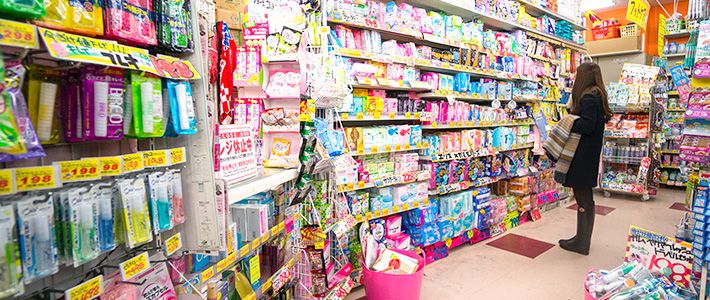
Drugstores in Japan
Lifestyle- English
- 日本語
- 简体字
- 繁體字
- Français
- Español
- العربية
- Русский
All Your Daily Necessities
Japanese drugstores began taking on their current form in the 1990s after several retailers began expanding their selection of merchandise, placing special emphasis on beauty products. Today, cosmetics and other products are as important an aspect of business as pharmaceuticals, with outlets devoting large swaths of shelf space to both segments. Over time, stores have increased their product range, allowing shoppers to browse for such daily necessities as over-the-counter medicines, personal care products, baby goods, pet supplies, and toiletries, as well as fresh and frozen foods, snacks, soft drinks, and liquor.
The popularity of drugstores has steadily grown, bolstered by the appeal of one-stop-shopping, the clean and pleasant environment of stores, low prices, and product quality, with both local and chain outlets becoming regular aspects of consumer life. Shops boast a wide variety of customers, with young women and housewives making up a significant portion of patrons.
Unlike cosmetic corners at department stores, with clerks stationed at each counter, shoppers are free to peruse different samples at their leisure and only need to ask for assistance when necessary. This has helped boost the status of stores among regular customers and has even led to a phenomenon where patrons may visit a drugstore just to do their make-up. Far from discouraging this behavior, stores have been quick to answer demand, with some offering personal care treatment as well as self-beauty and nail salon services at discount rates.
Tax-Exempt Shopping
In October 2014 the Japanese government, anticipating a rise in foreign tourists, moved to broaden the scope of tax-exempt shopping for overseas visitors. Enticed by the large variety of tax-free items, tourists are increasingly turning to drugstores for their favorite health and beauty products and to stock up on snacks and other souvenirs for friends and family back home. As the number of travelers from neighboring Asian countries has grown, shops in select locations have begun to offer service in other languages, including Chinese and Korean.
According to the new guidelines, a tourist presenting a passport can make from ¥5,000 to ¥500,000 in tax-free purchases at one outlet per day. For more information on tax-free shops, see the Japan Tourism Agency webpage.
The Development of Japanese Drugstores
Traditionally, Japanese pharmacies, known as yakkyoku, specialized mainly in over-the-counter and prescription medicines. Starting in the 1970s, however, shops following the US model of providing a wide selection of nonmedical merchandise at low prices began to appear. The self-makeover at Japanese drugstores proved to be a hit. According to Ministry of Economy, Trade, and Industry figures for September–October 2014, sales at Japan’s more than 13,200 drugstores totaled over ¥388 billion.
Drugstore interiors tend to be less spread out than large-scale supermarkets, boosting their attraction for busy shoppers. Extensive selection and discount prices have also made them popular stop-offs, with many people choosing to visit neighborhood outlets rather than nearby convenience stores. In addition, many shops use the latest hit songs and specially tooled campaign information to present a vibrant store image, attracting customers with music and advertisements that spill through the front doors out onto the street.
Japanese drugstores continue to evolve, winning new domestic and international customers by steadily rolling out new products and services at discount prices.
(Banner photo courtesy of Aaron G.)